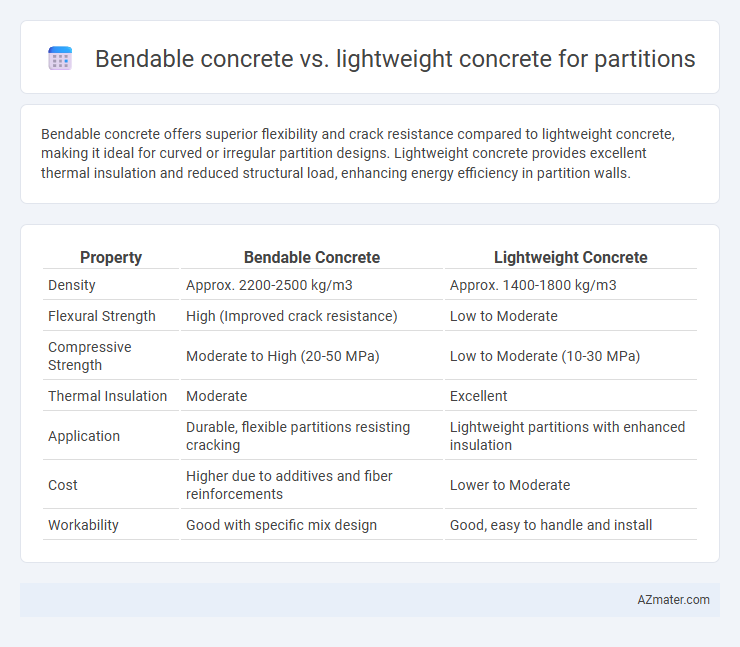Bendable concrete offers superior flexibility and crack resistance compared to lightweight concrete, making it ideal for curved or irregular partition designs. Lightweight concrete provides excellent thermal insulation and reduced structural load, enhancing energy efficiency in partition walls.
Table of Comparison
| Property | Bendable Concrete | Lightweight Concrete |
|---|---|---|
| Density | Approx. 2200-2500 kg/m3 | Approx. 1400-1800 kg/m3 |
| Flexural Strength | High (Improved crack resistance) | Low to Moderate |
| Compressive Strength | Moderate to High (20-50 MPa) | Low to Moderate (10-30 MPa) |
| Thermal Insulation | Moderate | Excellent |
| Application | Durable, flexible partitions resisting cracking | Lightweight partitions with enhanced insulation |
| Cost | Higher due to additives and fiber reinforcements | Lower to Moderate |
| Workability | Good with specific mix design | Good, easy to handle and install |
Introduction to Modern Concrete Solutions for Partitions
Bendable concrete offers enhanced flexibility and crack resistance, making it ideal for modern partition designs requiring durability and aesthetic appeal. Lightweight concrete reduces structural load and improves thermal insulation, benefiting partitions in multi-story buildings and energy-efficient constructions. Both materials represent advanced solutions tailored for contemporary partition applications, balancing strength, weight, and design versatility.
What is Bendable Concrete?
Bendable concrete, also known as ultra-ductile concrete, is engineered to withstand significant tensile strain and bending forces without cracking, making it ideal for flexible partition walls that require durability and resilience. Unlike traditional lightweight concrete, which prioritizes reduced density and thermal insulation, bendable concrete incorporates specially designed fibers to enhance toughness and flexibility. This material offers superior resistance to impact and deformation, ensuring longer-lasting partitions in both residential and commercial applications.
What is Lightweight Concrete?
Lightweight concrete is a type of concrete that incorporates lightweight aggregates such as expanded clay, shale, or pumice, resulting in a material with reduced density and enhanced thermal insulation properties. It offers improved fire resistance and sound absorption, making it ideal for partition walls where weight reduction and energy efficiency are priorities. Compared to bendable concrete, lightweight concrete provides easier handling and installation but lacks the same flexibility and tensile strength.
Key Material Properties Comparison
Bendable concrete exhibits high tensile strength and enhanced ductility due to fiber reinforcement, making it ideal for partitions requiring flexibility and crack resistance. Lightweight concrete offers reduced density and better thermal insulation, which is beneficial for energy-efficient partition walls but has lower tensile strength compared to bendable concrete. The choice between these materials depends on prioritizing mechanical performance versus weight and insulation properties in partition construction.
Structural Performance in Partition Applications
Bendable concrete provides superior tensile strength and crack resistance compared to lightweight concrete, making it ideal for partitions requiring enhanced durability and flexibility. Lightweight concrete offers reduced weight and improved thermal insulation, but its lower structural capacity limits its use in high-load partition walls. For partition applications demanding both strength and resilience, bendable concrete delivers better structural performance by accommodating deformation without failure.
Flexibility vs. Weight: Pros and Cons
Bendable concrete offers superior flexibility, making it ideal for partitions requiring slight curvature or resistance to cracking under stress, but it typically has a higher density compared to lightweight concrete. Lightweight concrete significantly reduces the overall partition weight, enhancing ease of installation and structural load efficiency, although it may lack the tensile strength and flexibility found in bendable concrete. Selecting between the two depends on the specific project requirements, balancing the need for structural flexibility against the benefits of weight reduction.
Durability and Longevity Analysis
Bendable concrete exhibits superior durability and enhanced crack resistance compared to lightweight concrete, making it ideal for partition walls requiring flexibility under stress without compromising structural integrity. Lightweight concrete offers reduced density and thermal insulation but generally demonstrates lower strength and higher susceptibility to damage over time, potentially shortening the lifespan of partitions. Durability assessments reveal bendable concrete's fiber-reinforced matrix significantly extends longevity by preventing micro-cracks, whereas lightweight concrete partitions may require frequent maintenance due to brittleness and moisture sensitivity.
Installation Methods and Ease of Use
Bendable concrete uses engineered fibers that enhance flexibility, allowing easier shaping and installation on curved partitions without extensive structural support, reducing labor time. Lightweight concrete, composed of lightweight aggregates like expanded polystyrene or pumice, is easier to handle and install due to its reduced weight but may require additional reinforcements for structural integrity. Both offer simplified installation compared to traditional concrete, with bendable concrete excelling in adaptability and lightweight concrete providing easier manual handling.
Cost-Effectiveness for Partition Projects
Bendable concrete offers enhanced durability and flexibility, reducing maintenance and repair costs in partition projects, which can lead to long-term cost savings despite higher initial material expenses. Lightweight concrete provides significant savings in transportation and installation due to its reduced weight, making it cost-effective for large-scale partitions where structural load and ease of handling are critical. Evaluating project-specific requirements such as load-bearing capacity, durability needs, and installation logistics determines the optimal cost-effective choice between bendable and lightweight concrete for partitions.
Sustainability and Environmental Impact
Bendable concrete offers enhanced durability and crack resistance, reducing the need for frequent repairs and thereby lowering overall material consumption and waste. Lightweight concrete, with its reduced density, improves energy efficiency in buildings by providing superior thermal insulation, which decreases heating and cooling demands. Both materials contribute to sustainability by optimizing resource use--bendable concrete through extended lifespan and lightweight concrete through energy conservation--making them environmentally preferable options for partition construction.

Infographic: Bendable concrete vs Lightweight concrete for Partition
 azmater.com
azmater.com